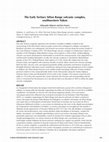Papers by Aleksandar Miskovic
Lunar and Planetary Science Conference, Mar 1, 2009

The results of a coupled, in situ, laser ablation–inductively coupled plasma–mass spectrometry (L... more The results of a coupled, in situ, laser ablation–inductively coupled plasma–mass spectrometry (LA-ICP-MS) U-Pb study on zircon and geochemical characterisation of the Eastern Cordilleran intrusives of Peru reveal 1.15 Ga of intermittent magmatism along central western Amazonia, the Earth's oldest active open continental margin. The eastern Peruvian batholiths are volumetrically dominated by plutonism related to the assembly and breakup of Pangea during the Paleozoic-Mesozoic transition. A Carboniferous-Permian (340- 285 Ma) continental arc is identified along the regional orogenic strike from the Ecuadorian border (6oS) to the inferred inboard extension of the Arequipa-Antofalla terrane in southern Peru (14oS). Widespread crustal extension and thinning, which affected western Gondwana throughout the Permian and Triassic resulted in the intrusion of the late- to posttectonic La Merced-San Ramon-type anatectites dated between 275 and 220 Ma, while the emplacement of the southern ...
Geochimica et Cosmochimica Acta, 2018

Geochemical Perspectives Letters, 2018
The origin of the peridotites that form cratonic mantle roots is a central issue in understanding... more The origin of the peridotites that form cratonic mantle roots is a central issue in understanding the history and survival of Earth's oldest continents. A longstanding hypothesis holds that the unusual bulk compositions of some cratonic peridotites stem from their origin as subducted oceanic serpentinite, dehydrated during subduction to form rigid buoyant keels . We present oxygen isotope data from 93 mantle peridotites from five different Archean cratons to evaluate their possible origin as serpentinites. Cratonic mantle peridotite shows remarkably uniform δ 18 O values, identical to modern MORB-source mantle, that do not vary with bulk rock Si-enrichment or Ca-depletion. These data clearly conflict with any model for cratonic lithosphere that invokes serpentinite as a protolith for cratonic peridotite, and place additional constraints on cratonic mantle origins. We posit that the uniform δ 18 O was produced by sub-arc and/or MOR depletion processes and that the Si-enriched nature of some samples is unlikely to be related to slab melt infiltration. Instead, we suggest a peridotitic source of Si-enrichment, derived from ascending mantle melts, or a water-fluxed depleted mantle. These variably Si-enriched, cratonic mantle protoliths were then collisionally compressed into the thick cratonic roots that have protected Earth's oldest continental crust for over 2.5 Gyr.

A striking geochemical relationship exists between the three principal plutonic belts of the East... more A striking geochemical relationship exists between the three principal plutonic belts of the Eastern Cordillera of Peru: 1) Mississippian to Pennsylvanian, I-type, metaluminous, hornblende and magnetite dominated granitoids are restricted to the segment north of 11S, and display calc-alkaline evolutionary trends with elevated LILE/HFSE ratios characteristic of continental subduction zones; 2) Permian to Early Triassic, peraluminous, I to S-type, mica and ilmenite rich granitoids of the east-central Peru, are comagmatic with the bimodal tholeiitic lavas of the Mitu Group, and characterized by restricted bimodal compositional range, moderate Fe enrichments, low LILE/HFSE values, and higher Ga/Al ratios, all of which are associated with transitional, post-orogenic (within-plate) suites; 3) Late Triassic, initially A-type monzogranitoids of the southern Cordillera de Carabaya terminate as peralkaline, SiO2-undersaturated intrusives (Ne-syenites) of the Allincapac complex emplaced in the...
Experimental phase relations predict that hydrous silicates can be buried deep in a growing plane... more Experimental phase relations predict that hydrous silicates can be buried deep in a growing planet. Relations between hydrous minerals and vapor-saturated solidus in martian mantle are investigated during the early planetary differentiation.

Precambrian Research, 2008
Neoproterozoic Palaeogeographic reconstructions of Rodinia conventionally place the western (Prot... more Neoproterozoic Palaeogeographic reconstructions of Rodinia conventionally place the western (Proto-Andean) margin of Amazonia against the eastern (Appalachian) margin of Laurentia. Separation and formation of the Iapetus Ocean is generally considered to have occurred later at ∼550 Ma. We examine the U-Pb detrital zircon "fingerprint" of autochthonous rocks from the northern and central segments of the Proto-Andean margin, which formed part of the western margin of Amazonia during the Late Neoproterozoic-Phanerozoic. The Proto-Andean margin is clearly the most feasible source region for most of the zircon grains, except for a 550-650 Ma sub-population, broadly age-equivalent to the Brasiliano/Pan-African Orogeny in eastern Amazonia. No obvious source for this detritus is known in the northern and central Andes. Derivation from eastern Amazonia is considered unlikely due to the stark paucity of detritus derived from the core of the Amazonian craton. Instead, we propose that a Late Neoproterozoic magmatic belt is buried beneath the present-day Andean belt or Amazon Basin, and was probably covered during the Eocene-Oligocene. If this inferred Neoproterozoic belt was an active margin, it would record the initiation of Proto-Andean subduction and imply at least partial separation of West Gondwana from its conjugate rift margin of eastern Laurentia prior to ca. 650 Ma. This separation may be linked to the ca. 770-680 Ma A-type magmatism found on eastern Laurentia in the southern Appalachians, and on the Proto-Andean margin in the Sierra Pampeanas and the Eastern Cordillera of Peru.

Journal of South American Earth Sciences, 2010
Grenvillian crust is encountered in several basement inliers in the northern Andes of Colombia, E... more Grenvillian crust is encountered in several basement inliers in the northern Andes of Colombia, Ecuador and Peru and is also represented as a major detrital or inherited component within Neoproterozoic to Paleozoic sedimentary and magmatic rocks. This review of the tectonic and geochronological record of the Grenvillian belt in the northern Andes suggests that these crustal segments probably formed on an active continental margin in which associated arc and back-arc magmatism evolved from ca. 1.25 to 1.16 Ga, possibly extending to as young as 1.08 Ga. The lithostratigraphic and tectonic history of the Grenvillian belt in the northern Andes differs from that of the Sunsas belt on the southwest Amazonian Craton and from the Grenvillian belt of Eastern Laurentia. It is considered that this belt, along with similar terranes of Grenvillian age in Middle America and Mexico define a separate composite orogen which formed on the northwestern margin of the Amazonian Craton. Microcontinent accretion and interaction with the Sveconorwegian province on Baltica is a feasible tectonic scenario, in line with recent paleogeographic reconstructions of the Rodinian supercontinent. Although Phanerozoic tectonics may have redistributed some of these terranes, they are still viewed as para-autocthonous domains that remained in proximity to the margin of Amazonia. Paleogeographic data derived from Phanerozoic rocks suggest that some of the Colombian Grenvillian fragments were connected to northernmost Peru and Ecuador until the Mesozoic, whereas the Mexican terranes where attached to the Colombian margin until Pangea fragmentation in Late Triassic times.

International Geology Review, 2010
Plate tectonic reconstructions of the late Mesoproterozoic-Neoproterozoic supercontinent of Rodin... more Plate tectonic reconstructions of the late Mesoproterozoic-Neoproterozoic supercontinent of Rodinia juxtapose the western margin of Amazonia against eastern Laurentia based on palaeomagnetic, isotopic, and geological evidence. Mesoproterozoic ('Grenvillian') orogenic belts are of crucial importance to these reconstructions as they act as key tectonic tracers for Amazonia-Laurentia interactions. They include orogenic belts sited on Amazonia (such as the Sunsás Orogen), paraautochthonous elements such as the Mesoproterozoic metamorphic basement inliers within the Andean Belt (e.g. in the Colombian Andes), exotic terranes accreted to Amazonia during Rodinia assembly (such as the Arequipa Massif), and orphaned fragments of Amazonian basement in Central and North America. A review of the timing of Sunsás orogenesis demonstrates that it occurred from about 1.2-1 Ga in eastern Bolivia and the western Amazon region of Brazil. This is significantly older than the timing of metamorphism in Mesoproterozoic basement inliers of the Colombian Andes, which record a late metamorphic event between 0.9 and 1.0 Ga. Orphaned fragments of Amazonian basement in Laurentia (such as the Blue Ridge/Mars Hill terrane) suggest collision between southeastern Laurentia and Amazonia at ca. 1.15 Ga. The Arequipa Massif (and Antofalla Basement) most likely represents an exotic basement terrane that was caught up in the collision of southeastern Laurentia with western Amazonia. Recent palaeomagnetic data suggest that Amazonia moved northeastwards along the eastern Laurentian margin during Grenvillian collision. Amazonia evidently collided with southern Laurentia at ca. 1200 Ma and, as a result of progressive dextral transcurrent movement, it encountered the Labrador-Greenland sector of eastern Laurentia (and possibly Baltica) by 980 Ma. The timing of the Rodinia break-up in western Amazonia is poorly constrained. Evidence exists supporting a Neoproterozoic western Amazonian active margin, which would imply its at least partial separation from the conjugate rift margin of eastern Laurentia (i.e. formation of a proto-Iapetus Ocean) prior to ca. 650 Ma. This rifting event may be linked to A-type magmatism at ca. 770-690 Ma which is documented in both southeast Laurentia and western Amazonia. Final separation must have been completed by Early Cambrian times based on the unequivocal evidence for drift-related sedimentation on the Laurentian margin of the Iapetus Ocean.

Geological Society of America Bulletin, 2007
Cordilleras of Peru and Ecuador using a combination of laser-ablation-inductively coupled plasma-... more Cordilleras of Peru and Ecuador using a combination of laser-ablation-inductively coupled plasma-mass spectrometry detrital zircon analysis and dating of syn-and posttectonic intrusive rocks by thermal ionization mass spectrometry and ion microprobe. The majority of detrital zircon samples exhibits prominent peaks in the ranges 0.45-0.65 Ga and 0.9-1.3 Ga, with minimal older detritus from the Amazonian craton. These data imply that the Famatinian-Pampean and Grenville (= Sunsas) orogenies were available to supply detritus to the Paleozoic sequences of the north-central Andes, and these orogenic belts are interpreted to be either buried underneath the present-day Andean chain or adjacent foreland sediments. There is evidence of a subduction-related magmatic belt (474-442 Ma) in the Eastern Cordillera of Peru and regional orogenic events that preand postdate this phase of magmatism. These are confi rmed by ion-microprobe dating of zircon overgrowths from amphibolite-facies schists, which reveals metamorphic events at ca. 478 and ca. 312 Ma and refutes the previously assumed Neoproterozoic age for orogeny in the Peruvian Eastern Cordillera. The presence of an Ordovician magmatic and metamorphic belt in the north-central Andes demonstrates that Famatinian metamorphism and subduction-related magmatism were continuous from Patagonia through northern Argentina to Venezuela. The evolution of this extremely long Ordovician active margin on western Gondwana is very similar to the Taconic orogenic cycle of the eastern margin of Laurentia, and our fi ndings support models that show these two active margins facing each other during the Ordovician.
Earth and Planetary Science Letters, 2009
... by the regional variability within coeval intrusive suites along the proto-Andean margin. ...... more ... by the regional variability within coeval intrusive suites along the proto-Andean margin. ... peralkaline nepheline syenites are markedly different from a mild subduction-zone trace element ... Ordovician post-collisional intrusive, and iv) Early Jurassic within-plate, peralkaline plutons ...

dsp-psd.pwgsc.gc.ca
The early Tertiary magmatic episode in the northern Canadian Cordillera is linked to the restruct... more The early Tertiary magmatic episode in the northern Canadian Cordillera is linked to the restructuring of the Kula-North American plate system from orthogonal to oblique convergence. Resultant volcanism was widespread, and remnant successions outcrop along the eastern margin of the Coast Plutonic Complex (CPC). The Sifton Range volcanic complex of southwestern Yukon is a member of the Paleogene Sloko-Skukum Group, and comprises a 900-m thick, shallow-dipping, volcanic succession dominated by intermediate to evolved lava and pyroclastic rocks deposited in a northwesterly trending half-graben. Locally, the volcanic sequence is intruded by alkali-feldspar granites of the CPC's Nisling Plutonic Suite dated at 57.5 Ma. Felsite sills radiate from the main intrusive body, and together with numerous basaltic to dacitic dykes traverse the volcanic package. Both the felsic volcanic rocks and epizonal granitoids exhibit anomalous enrichments in large-ion lithophile elements indicating crustal contributions during the late-stage petrogenesis of the complex. In addition, the Sifton Range intrusive rocks exhibit modal mineralogy reflective of lower ambient pressures relative to the compositionally similar Annie Ned granites along the Alaska Highway between Stony Creek and Mendenhall, 20 km south of the complex. The amount of post-Eocene uplift (ca. 30 m/Ma) that exposed the contact between the intrusive and corresponding volcanic rocks is constrained by the presence of a calc-silicate bed at an elevation of 1830 m within the upper volcanic stratigraphy.

Geological Society of America Bulletin, 2009
The results of a coupled, in situ laser ablation-inductively coupled plasma-mass spectrometry (LA... more The results of a coupled, in situ laser ablation-inductively coupled plasma-mass spectrometry (LA-ICP-MS) U-Pb study on zircon and geochemical characterization of the Eastern Cordilleran intrusives of Peru reveal 1.15 Ga of intermittent magmatism along central Western Amazonia, the Earth's oldest active open continental margin. The eastern Peruvian batholiths are volumetrically dominated by plutonism related to the assembly and breakup of Pangea during the Paleozoic-Mesozoic transition. A Carboniferous-Permian (340-285 Ma) continental arc is identifi ed along the regional orogenic strike from the Ecuadorian border (6°S) to the inferred inboard extension of the Arequipa-Antofalla terrane in southern Peru (14°S). Widespread crustal extension and thinning, which affected western Gondwana throughout the Permian and Triassic resulted in the intrusion of the late-to posttectonic La Merced-San Ramón-type anatectites dated between 275 and 220 Ma, while the emplacement of the southern Cordillera de Carabaya peraluminous granitoids in the Late Triassic to Early Jurassic (220-190 Ma) represents, temporally and regionally, a separate tectonomagmatic event likely related to resuturing of the Arequipa-Antofalla block. Volcano-plutonic complexes and stocks associated with the onset of the present Andean cycle defi ne a compositionally bimodal alkaline suite and cluster between 180 and 170 Ma. A volumetrically minor intrusive pulse of Oligocene age (ca. 30 Ma) is detected near the southwestern Cordilleran border with the Altiplano. Both post-Gondwanide (30-170 Ma), and Precambrian plutonism (691-1123 Ma) are restricted to isolated occurrences spatially comprising less than 15% of the Eastern Cordillera intrusives. Only one remnant of a Late Ordovician intrusive belt is recognized in the Cuzco batholith (446.5 ± 9.7 Ma) indicating that the Famatinian arc system previously identifi ed in Peru along the north-central Eastern Cor di llera and the coastal Arequipa-Antofalla terrane also existed inboard of this parautochthonous crustal fragment. Hitherto unknown occurrences of late Mesoproterozoic and middle Neoproterozoic granitoids from the south-central cordilleran segment defi ne magmatic events at 691 ± 13 Ma, 751 ± 8 Ma, 985 ± 14 Ma, and 1071-1123 ± 23 Ma that are broadly coeval with the Braziliano and Grenville-Sunsás orogenies, respectively. Our data suggest the existence of a continuous orogenic belt in excess of 3500 km along Western Amazonia during the formation of Rodinia, its "early" fragmentation prior to 690 Ma, and support a model of reaccretion of the Paracas-Arequipa-Antofalla terrane to western Gondwana in the Early Ordovician with subsequent detachment of the Paracas segment in form of the Mexican Oaxaquia microcontinent in Middle Ordovician. A tectonomagmatic model involving slab detachment, followed by underplating of cratonic margin by asthenospheric mantle is proposed for the genesis of the volumetrically dominant Late Paleozoic to early Mesozoic Peruvian Cordilleran batholiths.
The uplifted plutons of the eastern Coast Plutonic Complex (CPC) of the northern Canadian Cordill... more The uplifted plutons of the eastern Coast Plutonic Complex (CPC) of the northern Canadian Cordillera are in contact with coeval volcanic suites of the early Tertiary Sloko-Skukum Group, and offer a unique opportunity for addressing the relationship between continental calc-alkaline volcanic sequences and subduction-related granitoid suites. The Sifton Range complex (SRC) is the Yukon's largest Paleogene erosional remnant (240 km2),

Lithos, 2006
The uplifted plutons of the eastern Coast Plutonic Complex (CPC) of the northern Canadian Cordill... more The uplifted plutons of the eastern Coast Plutonic Complex (CPC) of the northern Canadian Cordillera are in contact with coeval volcanic suites of the early Tertiary Sloko-Skukum Group, offering a unique opportunity to address the relationship between subduction-related, continental calc-alkaline volcanic sequences and their coeval granitoid suites. The Sifton Range volcanic complex (SRVC) of southwestern Yukon is intruded by CPC granites and displays a subduction-related geochemical signature with depletions in HFSE relative to LILE. The volcanic rocks range between mediumand high-K orogenic suites, and define a calc-alkaline fractionation trend. The epizonal potassium-feldspar granites are chemically similar to the SRVC rhyolites, and are characterized by highly fractionated LREE (La N / Sm N = 5-11), enrichments in LILE and Th (12-18 ppm). The SRVC exhibits a striking relationship between rock composition and style of eruption, with a reduction in abundance of lavas with increasing SiO 2 being correlated with the appearance of felsic pyroclastic rocks and granitic plutonism. Thermodynamic crystal fractionation models of the compositional interval between basaltic and dacitic andesite (52-61 wt.% SiO 2) are consistent with evolution at moderately hydrous (1.5 wt.% H 2 O), upper crustal (1.5 kbar) conditions, and fO 2 close to the QFM buffer. Neither assimilation-fractional crystallization (AFC), nor binary magma mixing models are capable of explaining the anomalously elevated Th contents in the SRVC felsic lavas and granites. Furthermore, unrealistically high contamination factors (r N 2.5) are required in AFC models to attain the incompatible-element concentrations of the SRVC granite and rhyolites, suggesting they represent distinct melts derived by anatexis of enriched upper crust, rather than the evolved products of the mafic SRVC magma. Changes in crystallinity during evolution of the SRVC magmas imply an abrupt rise in effective viscosity (from 10 6 to 10 10 Pa s) near the andesite-dacite transition as a result of the flocculation of plagioclase phenocrysts. The resultant increase in shear strength impeded crystal fractionation and eruption of lavas, and may account for the decrease in the abundance of flows with more than 62 wt.% SiO 2. The onset of explosive volcanism at c.a. 68 wt.% SiO 2 approximately coincides with the calculated saturation point of H 2 O at
Geochmica et Cosmochimica Acta








Uploads
Papers by Aleksandar Miskovic